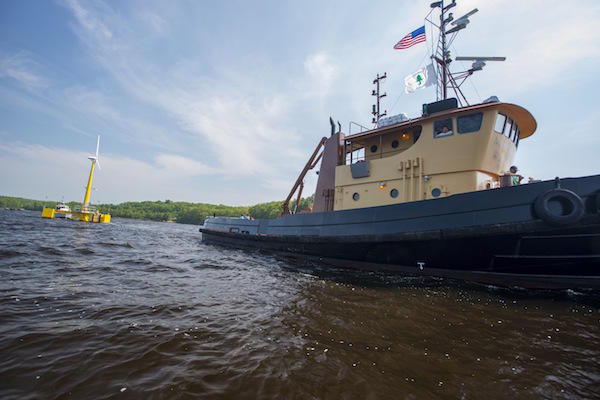Industry Heavyweights To Invest In UMaine Offshore Wind Project Near Monhegan Island

The University of Maine’s effort to pioneer floating offshore wind technology took a $100 million leap forward Wednesday with the announcement that two industry heavyweights are going to invest in development of the project near Monhegan Island. (VolturnUS and Maine Aqua Ventus)
The University of Maine’s effort to pioneer floating offshore wind technology took a $100 million leap forward Wednesday with the announcement that two industry heavyweights are going to invest in development of the project near Monhegan Island.
A subsidiary of the Mitsubishi company, called Diamond Offshore Wind, is joining with RWE Renewables to invest the $100 million to build and deploy a full-scale, floating wind farm at the site, about 14 miles off Maine’s coast. The new company, called New England Aqua-Ventus, will collaborate with the University of Maine composites program that was the incubator for the project’s unique floating-platform technology.
“It’s a big endeavor,” says Chris Wisseman, a long time executive in the offshore wind industry who will lead the new company. “It will take a couple years really, to get this off the ground right. To prove that we can build it with Mainers, deploy it safely and really use it as a laboratory for everybody to learn from.”
The investment signals the full rehabilitation of an effort that had withered during the governorship of Republican Paul LePage, a fierce opponent of renewable energy projects he characterized as over-dependent on consumer subsidies. Two years ago, his appointees to the state Public Utilities Commission put a hold on a power contract vital to taking the Aqua-Ventus technology beyond the scale-model prototype that was deployed off Castine in 2013.
But last year the Legislature passed a law signed by Democratic Gov. Janet Mills, directing the Commission to award a power contract to the project.
“That set the foundation for this project to take off,” says Wisseman. “So we come in as developer, we are essentially restarting development, selecting the final turbines, we are working on all the engineering details, and so the collaboration with the University is to finish that development, and now get it ready for construction.”
Read the rest of this story at Maine Public’s website.
